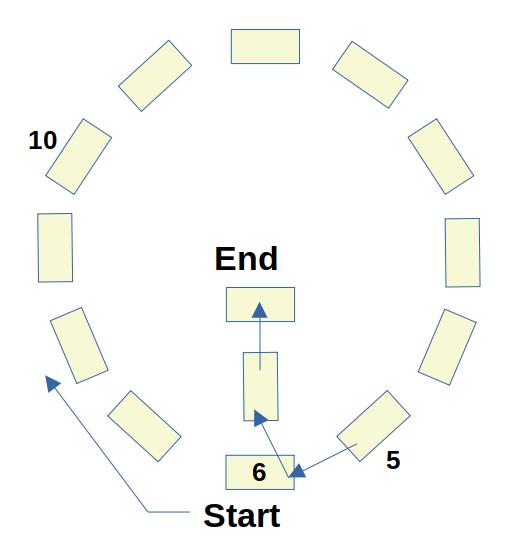Grandfather's Clock -- an Original Dice Game
Invented by Howard Fosdick (V 1.0) © BestFreeNewGames.com
Racing games are among the best. Witness Parcheesi and Backgammon. This game only requires dice and a card deck, yet it retains all the excitement of good race games.
For: 2 or 3 players.
Equipment:
- Three dice
- A marker for each player. You can use different-coloured poker chips, different coins, or markers from other games.
- One deck of playing cards
Objective: To win the race across a "board" composed of face-up playing cards.
Set Up: To create the card deck you'll use for this game, take a standard 52 card pack and remove all cards above the 10 (and any Jokers). So you'll end up with 40 cards, ranking Ace-2-3-4-5-6-7-8-9-10. The Ace has a value of 1 in this game.
Shuffle and deal out 14 cards face-up, as shown below:

Place all markers at Start (6 o'clock). The race proceeds clockwise through each card. When markers reach 6 o'clock again, they turn north onto the last two cards, as shown by the blue arrows. The first player to the card marked End wins the race.
Play: In his turn, a player roles the three dice.
To get to the next card, either one of the dice, or any combination of them, must match the value of that card.
For example, you roll a 1-3-5. Your full set of possible movements is 1, 3, 5, 4 (1 + 3), 8 (3 + 5), and 9 (1 + 3 + 5). So you can move your marker onto the next card if it is a 1, 3, 5, 4, 8, or 9.
If you can't move to the next card, your turn is over.
If you can move to the next card, any dice you did not apply to that card can be applied to the next one. So it is possible to move more than one card per turn.
For example, you roll a 1-3-5. The next card is a 5, and the one after that is a 4. You move to the 5 card based on your 5 die, then you move to the 4 card, based on your two dice 1 + 3. Then your turn ends.
If you roll doubles (a pair), you get another turn. You turn continues as long as you roll doubles.
The Bomb: If you roll triples (3 of a kind), you can exchange your marker with the leader's. Then your turn ends. If you're already in the lead, your turn ends without any result.
Bumping: For clock positions Start, 7, 8, and 9, more than one marker can reside on a card.
This changes at position 10, as shown in the diagram. From that point on, if you land on a card that already has a marker on it, you can bump that marker. (If playing with 3 players, you declare which of the two markers you will bump.)
To bump the marker, roll 1 die. If you roll an even number, the opponent's marker is moved one card back. If you roll an odd number, the opponent's marker is bumped 3 cards back (maximally back to Start).
After you bump a player -- or exchange markers due to rolling a Bomb -- your turn immediately ends. You do not roll again even if you rolled doubles or triples.
Winning: The first player to move his marker to the End card wins. He gets points equal to the number of cards back his opponent is. If playing with three, the winner gets the total number of cards back for both opponents added together.
License: Feel free to print, copy, and distribute these rules, so long as you retain this paragraph. Invented by Howard Fosdick © 2024, distributed under Creative Commons License BY-ND. HOME